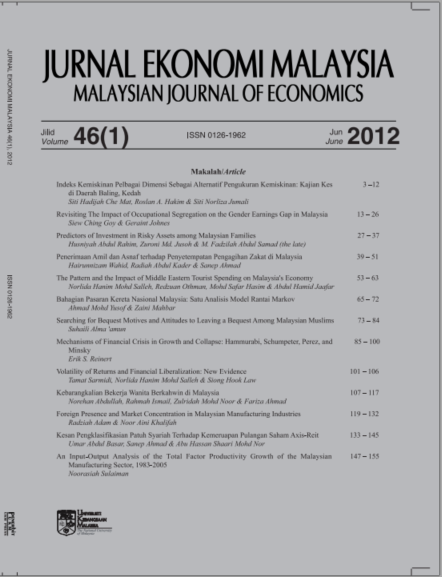Jurnal Ekonomi Malaysia
46 (1) 2012 27 – 37
Universiti Malaya
MALAYSIA
Abstract
Investment, as a strategy to enhance financial well-being, is exposed to high expected risk in order to gain high expected returns. This study focused on the effects of personality and behavioural factors in predicting investments in risky assets. The personality factors studied were future time orientation, financial risk tolerance and self-worth, whilst the behavioural factors concerned were the dimensions of financial management practices of families. Quota sampling based on ethnicity was used to sample a total of 800 respondents, namely the reported family financial managers from families residing in Peninsular Malaysia. Investment in risky assets was based on the self-reported investment in stocks. Binary logistic regression analysis revealed financial risk tolerance, self-worth, record-keeping, credit, savings and risk management as significant predictors of investment in risky assets. Family financial managers who were more risk-tolerant with higher self-worth tend to invest in risky assets. Furthermore, those who perform record-keeping; regularly save; and managing risk well were also more likely to invest in risky assets. However, those managing credit wisely were less likely to invest in risky assets. The most influential factors for predicting investment in risky assets found in this study were savings, followed by self-worth, risk practices, record-keeping and financial risk tolerance. The findings provided evidence that specific personality factors and financial management practices did predict investment in risky assets. Knowing these factors will enable financial planners to identify those with potential to invest in this type of asset and encourage them to invest in risky assets in order to gain greater return from their investment. As for those families having such personality and performing influential financial practices, they would realise their capability in risky investment. However, for those having low self-worth, less tolerating with financial risk and hardly did those influential financial practices, they could be trained to make them capable to invest in risky assets. More families would have the potential to invest in risky assets that can lead to financial stability in the long run. Additionally, this will contribute to the economic growth of the country.
Keywords
Similar Articles
- Does Firm Size Matter for the Financial Constraints?
- Was Bail-Out A Success? Evidence from the Investment-Cash Flow Relationship
- Macroeconomic Variables and In-Migration in Malaysia’s Developed States
Bibliography
@article{abdulrahim2012predictors,
title={Predictors of Investment in Risky Assets among Malaysian Families},
author={Abdul Rahim, Husniyah and Md. Jusoh, Zuroni and Abdul Samad, M. Fazilah},
journal={Jurnal Ekonomi Malaysia},
volume={46},
number={1},
pages={27—37},
}
Receive updates when new articles are published.


